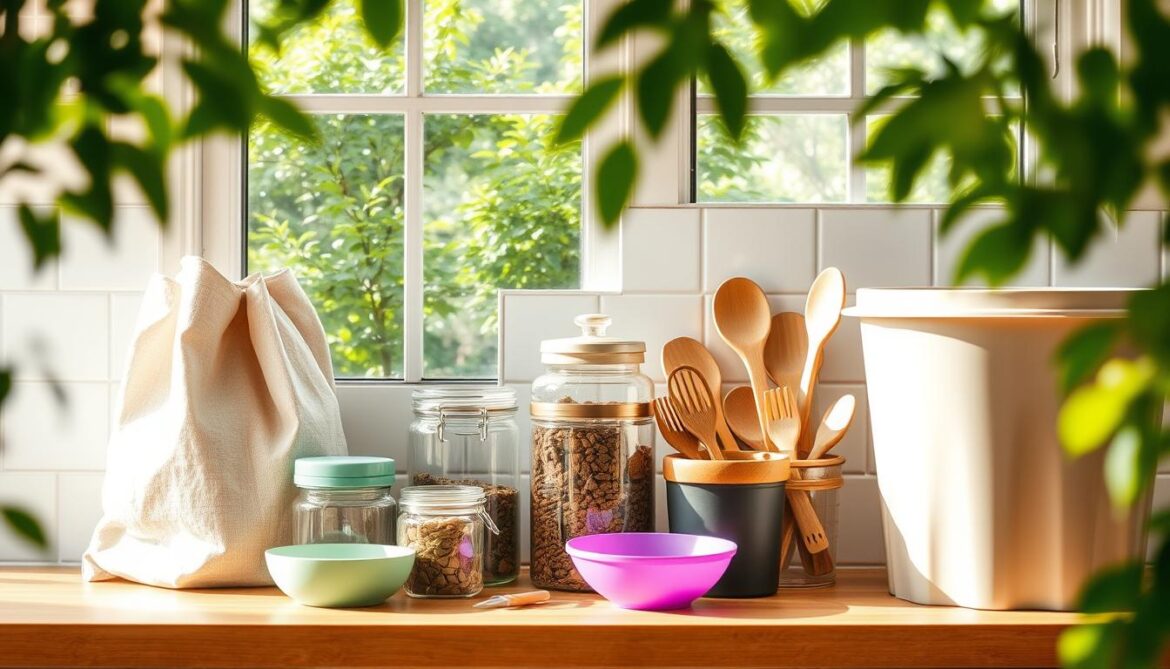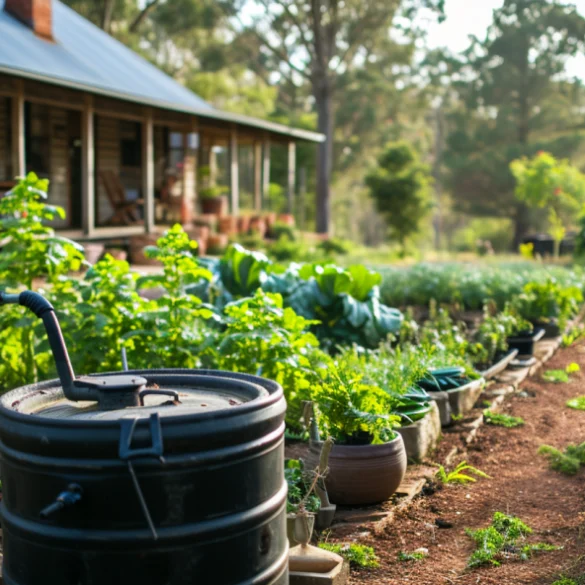Can your kitchen really produce zero waste? It might seem like a dream, but it’s possible with the right steps. A zero-waste kitchen is key to living sustainably and making your home eco-friendly. By using smart strategies, you’ll help the planet, save money, and keep your kitchen tidy.
A zero-waste kitchen is more than just recycling. It’s about changing how you shop, cook, and handle food and packaging. From buying package-free items to composting, every choice in your kitchen helps the environment. Let’s see how you can make your kitchen a green haven.
Starting a zero-waste kitchen takes time and creativity. You’ll find new uses for things you once threw away and get creative with food. This change is good for the planet and can also make cooking more fun and affordable.
Remember, small steps can make a big difference. Switching to reusable items, buying in bulk, or composting are all steps towards a greener home. Are you ready to make your kitchen greener and reduce waste? Let’s explore zero-waste living together!
Key Takeaways
- Zero-waste kitchens reduce environmental impact and save money
- Rethink shopping, cooking, and disposal habits
- Start with small, manageable changes
- Use reusable containers and shop in bulk
- Learn composting to minimize food waste
- Embrace creativity in using all parts of ingredients
- Sustainable practices lead to a more organized kitchen
What is a Zero-Waste Kitchen?
A zero-waste kitchen is at the core of living sustainably. It’s where you reduce waste and use eco-friendly methods. Your goal is to cut down on trash and use resources wisely.
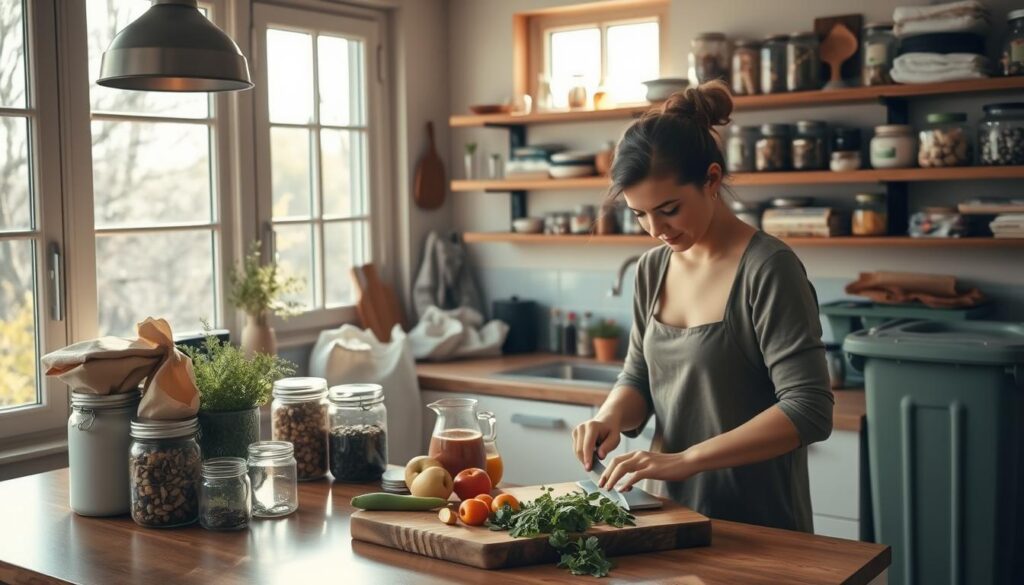
Understanding the Zero-Waste Movement
The zero-waste movement makes us think differently about our stuff. It encourages us to reduce waste and live sustainably. This idea applies to all areas of our lives, including the kitchen.
Key Principles of Zero-Waste Living
Zero-waste living in the kitchen focuses on five main points:
- Refuse unnecessary items
- Reduce what you use
- Reuse and repurpose
- Recycle when possible
- Rot (compost) organic waste
Benefits of a Zero-Waste Kitchen
Using sustainable kitchen practices has many advantages:
- Less environmental impact
- Money savings
- Healthier eating habits
- More organized space
Common Challenges and Solutions
Switching to a zero-waste kitchen can be hard. You might find it tough to find products without packaging or manage food scraps. Start small by replacing one disposable item with something reusable. As you go, you’ll build new habits and overcome these challenges.
How to Start Your Zero-Waste Kitchen Journey
Starting a zero-waste kitchen journey is a fun step towards a greener life. Small changes can make a big difference. They help reduce waste and make your home more eco-friendly.
Assessing Your Current Kitchen Waste
First, track your kitchen waste for a week. Note what you throw away most. This shows where you can do better and helps you see your progress.
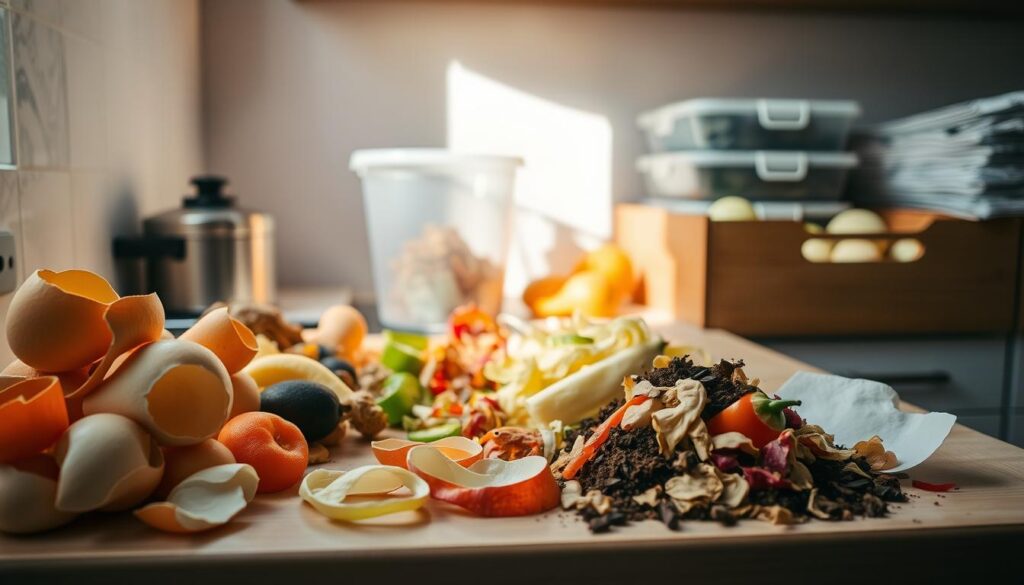
Setting Realistic Zero-Waste Goals
After assessing, set goals you can reach. Start with simple things like using fewer plastic bags or composting. As you get better, you can aim for more.
Essential Mindset Shifts for Success
Changing how you think is key to success. Focus on quality, not quantity. See waste as something to be used, not thrown away. Remember, it’s about making progress, not being perfect.
Building a Sustainable Shopping Routine
Make a shopping plan that helps your zero-waste goals. Use reusable bags and containers. Buy in bulk and choose items without packaging. Also, pick local, seasonal foods to cut down on carbon emissions.
- Plan meals to reduce food waste
- Buy in bulk to minimize packaging
- Support local farmers markets
By following these tips, you’re on your way to a zero-waste kitchen. Every little step helps make the future greener.
Zero-Waste Food Storage Solutions
Switching to zero-waste food storage can change your kitchen. Using reusable containers and plastic-free options cuts down on waste. It also keeps your food fresh for longer. Let’s look at some practical ways to make your pantry zero-waste and change how you store food.
Best Reusable Containers and Alternatives
Get rid of single-use plastics and choose eco-friendly options. Glass jars, stainless steel containers, and silicone bags are great for different foods. These containers reduce waste and keep your food fresh and visible.
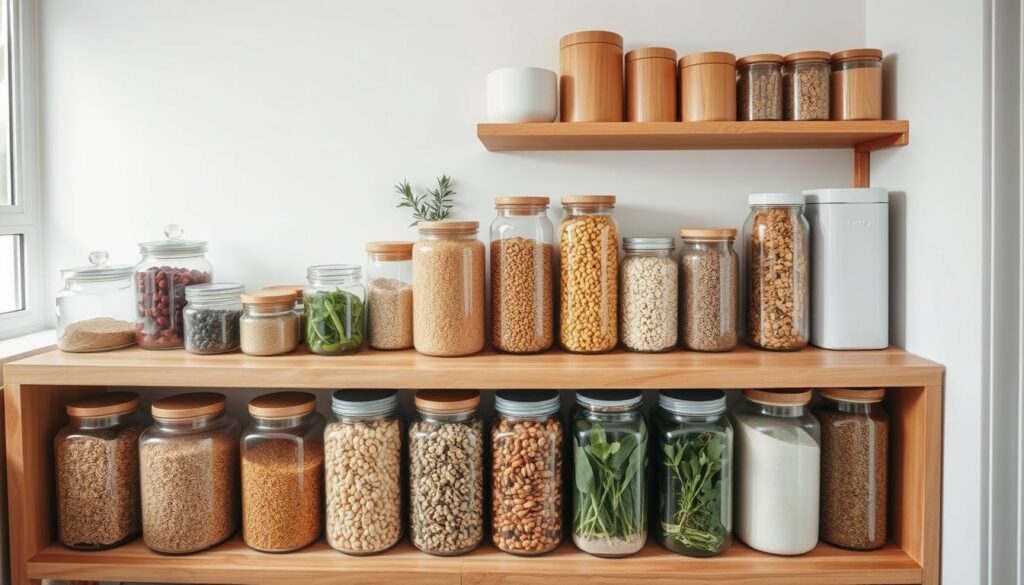
Storing Food Without Plastic
Storing food without plastic is simple. Use cloth bags for fruits and veggies, and reuse containers for dry goods. A device that checks temperature and sends alerts can help keep food fresh. This supports your zero-waste journey.
DIY Beeswax Wraps and Eco-Friendly Options
Try making beeswax wraps as a green alternative to plastic wrap. They’re great for covering bowls or wrapping sandwiches. You can also use silicone lids and cloth covers, which are easy to clean and reuse.
Organizing a Zero-Waste Pantry
Turn your pantry into a zero-waste space with clear jars and containers for bulk items. Label everything and group similar items. Use garages or attics for seasonal storage to make the most of space and support zero-waste living.
By using these zero-waste food storage tips, you’ll make your kitchen more sustainable. You’ll also keep your food fresh and organized. Remember, small steps can make a big difference in reducing waste and living greener.
Smart Grocery Shopping for a Zero-Waste Kitchen
Turning your kitchen into a zero-waste space starts with smart shopping. By changing your habits and making thoughtful choices, you can cut down on waste. This supports eco-friendly practices.
Mastering Bulk Shopping
Bulk shopping is key to living zero-waste. Carry your own containers, bags, and jars for grains, nuts, and spices. This method cuts down on packaging and lets you buy just what you need. Always weigh your containers before filling to get the right price.
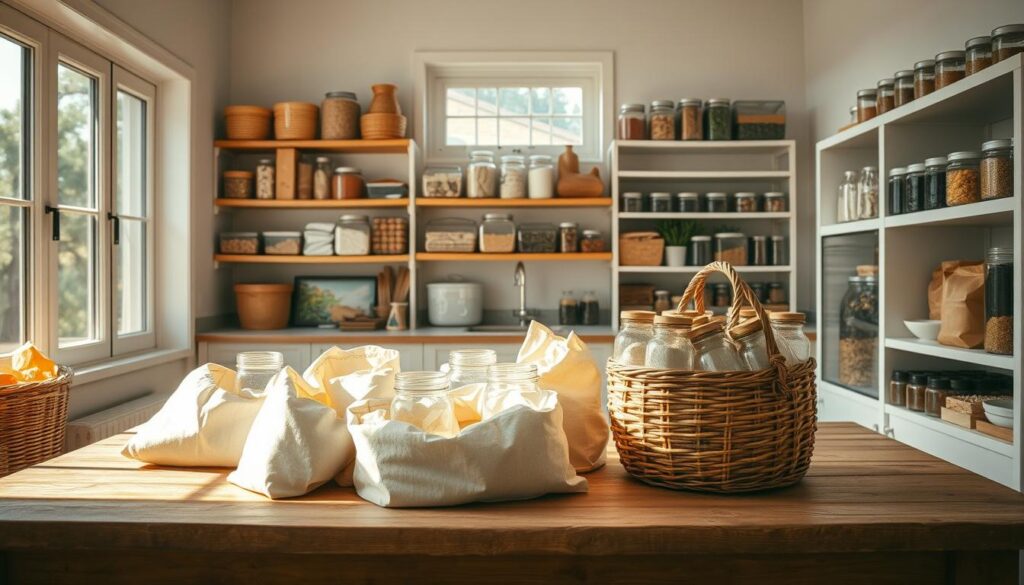
Selecting Packaging-Free Foods
Look for foods without packaging at farmers markets, local stands, and zero-waste stores. Pick loose fruits and veggies over packaged ones. When you can, choose items in compostable or recyclable packaging.
Finding Zero-Waste Friendly Stores
Find stores in your area that sell package-free products. These shops have a variety of items, including food and personal care products in bulk. Also, check out local co-ops and health food stores for bulk sections.
Advocating for Waste-Free Options
Talk to store managers about adding more bulk and packaging-free items. Let them know you’re interested in zero-waste shopping and suggest products you’d like to see. Your input can lead to changes in your local stores.
Composting: A Key Component of a Zero-Waste Kitchen
Composting is key to cutting down kitchen waste and making soil rich in nutrients. By using home composting methods, you can lessen your environmental footprint. Plus, it helps your garden grow better.
Different Types of Composting Methods
There are many composting methods for different homes. Backyard composting means making a pile of organic stuff in your yard. Vermicomposting uses worms to break down kitchen scraps, great for apartments. Bokashi composting ferments food waste, including meat and dairy, in a sealed container.
What Can and Can’t Be Composted?
Most fruit and veggie scraps, coffee grounds, and eggshells are great for composting. But, don’t add meat, dairy, oils, or sick plants. These can attract pests or harm your compost.
Setting Up a Composting System at Home
To start composting at home, pick a container that fits your space. A simple plastic pail or stainless steel bin works well. For small spaces, freezing compost helps reduce odors and extends the time between taking it out.
Common Composting Mistakes to Avoid
Watch out for these common mistakes:
- Adding too many “green” materials without balancing with “browns”
- Neglecting to turn the compost regularly
- Letting the pile dry out or become too wet
- Placing the compost bin in direct sunlight
Avoiding these mistakes helps you make rich compost for your garden. It also reduces kitchen waste.
Cooking with Minimal Waste
Starting a zero-waste kitchen is easy with smart cooking. Use whole ingredients and get creative with leftovers. This way, you cut down on waste and enjoy tasty meals.
Using Every Part of Your Ingredients
Whole ingredient cooking means using everything. Don’t throw away carrot tops or broccoli stems! Carrot greens make a great pesto, and broccoli stems are perfect for stir-fries.
Even potato peels can be turned into crispy chips. Just season and bake them.
Creative Ways to Use Scraps and Leftovers
Turn kitchen scraps into new dishes. Use vegetable ends and peels to flavor homemade stock. Stale bread can be turned into croutons or breadcrumbs.
Leftover recipes help reduce waste. Yesterday’s roast chicken can become today’s chicken salad or soup.
Zero-Waste Meal Planning Strategies
Zero-waste meal planning means buying only what you need. Plan meals around similar ingredients to avoid leftovers. Choose versatile items for multiple recipes.
Keep track of what’s in your fridge and pantry. This helps you avoid buying too much.
Cooking Techniques That Reduce Waste
Some cooking methods help reduce waste. Batch cooking lets you make meals ahead of time, preventing spoilage. Techniques like pickling or fermenting keep produce fresh longer.
Freeze herbs in ice cube trays with oil. This way, you can use them in future dishes.
Reducing Single-Use Plastics in the Kitchen
Making your kitchen plastic-free is key to living sustainably. The world uses $125 billion worth of polymers every year. Yet, only 1% is recycled. This shows we need to use reusable items and eco-friendly cleaners.
Identifying Problematic Plastics
First, identify the plastics in your kitchen. Look at food storage, shopping bags, and packaging. Cleaning products also add to the problem, with 36 million tonnes made yearly.
Best Reusable Alternatives for Plastic Items
Choosing reusable items can greatly reduce waste. Use glass for food, cloth bags for shopping, and stainless steel for water. These options save money and reduce plastic use.
Transitioning Away from Plastic Packaging
Changing how you shop can help reduce plastic packaging. Buy in bulk, pick products with less packaging, and use your own containers. Bans on single-use plastics in some areas also help.
Finding Plastic-Free Cleaning Products
It’s important to use eco-friendly cleaners. Look for brands with biodegradable ingredients and refill options. The Sustainable PLFs 2040 aims to make more biodegradable products by 2030.
| Plastic Item | Reusable Alternative | Environmental Impact |
|---|---|---|
| Plastic water bottles | Stainless steel bottles | Prevents 97,000 plastic bottles from being discarded (based on a Chicago hotel case study) |
| Plastic food containers | Glass containers | Reduces microplastic contamination in food |
| Plastic cleaning bottles | Refillable glass bottles | Helps reduce the 99% of PLFs that end up in landfills or drains |
DIY Zero-Waste Kitchen Products
Making your own zero-waste kitchen products is fun and rewarding. It helps reduce your environmental impact. You can save money and avoid harmful chemicals by making your own cleaning supplies and kitchen products.
Making Your Own Cleaning Supplies
Homemade cleaning supplies are easy and effective. Mix equal parts water and white vinegar for a general cleaner. Add lemon juice for a fresh smell. For tough jobs, mix baking soda and water into a paste.
These simple recipes will keep your kitchen clean without harsh chemicals.
Homemade Natural Dishwashing Alternatives
DIY dish soap is a great choice instead of store-bought. Grate a bar of castile soap and mix with hot water. Add a few drops of essential oil for scent.
For the dishwasher, mix equal parts baking soda and borax with vinegar. This creates effective dishwasher tablets.
DIY Reusable Kitchen Towels and Napkins
Turn old t-shirts or bed sheets into reusable kitchen towels and napkins. Cut them into sizes you need, then hem the edges. These alternatives reduce paper waste and save money.
Eco-Friendly DIY Food Wraps and Covers
Eco-friendly food wraps are a great substitute for plastic wrap. To make beeswax wraps, melt beeswax onto cotton fabric with an iron. For bowl covers, sew elastic around circular fabric pieces.
| DIY Product | Main Ingredients | Estimated Cost |
|---|---|---|
| All-Purpose Cleaner | Water, Vinegar | $0.50 per bottle |
| Dish Soap | Castile Soap, Water | $1.00 per bottle |
| Beeswax Wrap | Cotton, Beeswax | $2.00 per wrap |
| Reusable Napkins | Upcycled Fabric | $0.25 per napkin |
Zero-Waste Kitchen Tools and Essentials
Starting a zero-waste kitchen begins with the right tools. Sustainable kitchen tools and eco-friendly cookware help reduce waste. Let’s look at the essentials to make your kitchen zero-waste.
Must-Have Zero-Waste Kitchen Items
Stock your kitchen with these sustainable tools:
- Glass storage containers
- Reusable produce bags
- Stainless steel straws
- Cloth napkins
- Bamboo utensils
Choosing Sustainable Utensils and Cookware
Choose eco-friendly cookware made from cast iron, stainless steel, or ceramic. These materials are durable and safe for cooking. Also, pick items with little packaging to cut down on waste.
Where to Find Zero-Waste Kitchen Supplies
You can find zero-waste supplies at different prices. Some start at £35.76, while others are £64.92. Don’t forget to add shipping costs, which are £3.95 to £4.95. Always check if items are in stock, as popular ones might be listed as “Low Stock” or “Available on Waitlist”.
Caring for Your Kitchen Tools
Proper care makes your tools last longer. Clean eco-friendly cookware gently and avoid harsh cleaners. Store items right to prevent damage. With proper care, your zero-waste kitchen tools will last for years.
Sustainable Water and Energy Use in the Kitchen
Creating a zero-waste kitchen is more than just cutting down on food waste. It’s also about saving water and using energy wisely. Making a few simple changes can help the planet and save you money.
Reducing Water Waste While Cooking
Water conservation in the kitchen is simple. Use a basin to wash fruits and veggies instead of running water. This water can then feed your plants. Also, save cooled water from boiling pasta or veggies for your garden.
These steps can greatly reduce your water use.
Energy-Efficient Cooking Techniques
Adopting energy-efficient cooking methods can help the environment. Batch cooking saves time and energy. Use lids on pots to keep heat in and cook faster.
Choose the right pot size for your burner to avoid wasting energy. These methods not only save energy but also keep your food’s nutrients intact.
Choosing Eco-Friendly Kitchen Appliances
When it’s time to replace kitchen appliances, choose eco-friendly ones. Look for energy star ratings and consider how long they last and if they can be repaired. Renewable energy sources like wind, solar, and hydropower are cheaper and more stable than traditional energy.
By making smart choices, you’ll make your kitchen more sustainable and save money in the long run.

